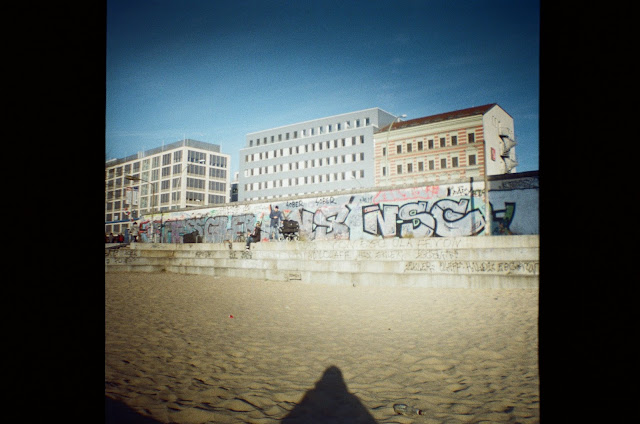We get off at the subway station Schlesiches Tor (U1) and after then we are crossing the bridge Oberbaumbrücke. The crossing of Oberbaumbrücke used to be one of several
possible crossings from the West Berlin exclave to East Berlin. The only
possible way to pass it at that time was by feet after paying a certain fee. In
case of an unauthorized extension of the stay, had the inhabitants of West
Berlin pay a special fee.
At the building near the bridge (at the end of the Falckensteinstraße), we recognize the mural
of the famous Italian street-artist Blu. He
depicted here the mythical character of Leviathan within the Berlin Mural Fest in 2007.
The huge Leviathan´s pink body consists of plenty other
smaller pink bodies, which stick together and form his figure. He grows by
eating the small men. Blu is one of the most critical mural creators in the
world. Director Lorenzo Fonda made a roadmovie-documentary MEGUNICA (2008), in which he explores Blu´s work within the common
South and Central America travels.
The Berlin Wall illuminates the sharp winter morning sunshine
/Wall as a gallery/. This is the place, where the locals and tourists know it
under the name East Side Gallery.
The colourful, several times redesigned tags appear up
to date. We can just hardly find a hint of the old wall-memories. The original graffiti
of the west side of the Wall are irreversibly gone. There is a vendor dressed in
black at the end of the Wall. He is offering some tiny souvenirs- nothing else
then little imitated pieces of the Wall. The nearby River of Spree is
reflecting the sun.
/The Wall as a witness of its time/. The original
paintings have been preserved on the eastern side of the Wall tough. Paradoxically,
as a protection against vandals, the city of Berlin had to build another wall
in the front of the original Wall. /The Wall as a tourist attraction/. In the
souvenir shop, you get everything from a former DDR-diary up to a postcard
showing the passionate fraternal kisses of Leonid Breschnew and Erich Honecker.
The Berlin Wall used to be not only irritating but
also inspiriting for many artists. „I can
remember/ Standing, by the wall/ And the guns, shot above our heads/ And we kissed,
as though nothing could fall/,“ sings David Bowie in Heroes (1977). The producer Tony Visconti claims, that Bowie was inspired
by his affair with the singer Antonia Maaß to create the Hero song. The recording studio was just 20-30 meters from the
Berlin Wall. Bowie was watching them through its window as Visconti kissed Maaß
on the background of the wall.
Bowie came to Berlin almost at the same time and for a similar reason as Iggy- because of the withdrawal treatment. In the mid-70s, they rented an apartment in the Schöneberg district and painted the walls in black. Bowie often sat on the one of the window frames and composed songs.
Bowie came to Berlin almost at the same time and for a similar reason as Iggy- because of the withdrawal treatment. In the mid-70s, they rented an apartment in the Schöneberg district and painted the walls in black. Bowie often sat on the one of the window frames and composed songs.
Vystúpime na zastávke Schlesisches Tor
(U 1) a potom kráčame po moste Oberbaumbrücke. Prechod Oberbaumbrücke bol jedným
z viacerých možných prechodov z exklávy Západný Berlín do Východného
Berlína. Dalo sa ním prejsť len pešky a za určitý poplatok. Za nepovolené
predĺženie jednodňového pobytu museli Západoberlínčania zaplatiť pokutu.
Na budove blízko mostu (koniec ulice Falckensteinstraße) spoznáme mural
známeho talianskeho pouličného umelca, ktorý si hovorí Blu. Na bočnej stene klubu Magnet
vyobrazil mýtickú postavu Leviathana v rámci berlínskeho festivalu
pouličných malieb murals Backjump Mural
v roku 2007.
Leviathan, miestami prezývaný aj ružový mužíček je zložený z mnohých
tiel na sebe nalepených malých mužíčkov a jedného si práve vkladá do úst. Blu
patrí medzi najkritickejších tvorcov murals na svete. Režisér Lorenzo Fonda
natočil o jeho tvorbe roadmovie-dokument MEGUNICA (2008), v ktorom spolu s ním cestuje po krajinách
Južnej a Strednej Ameriky mapujúc pritom jeho tvorbu.
Berlínsky múr dopoludnia osvetľuje ostré zimné slnko. Múr ako galéria. Na
tomto mieste ho miestni aj turisti poznajú aj pod názvom East Side Gallery.
Farebné, veľakrát prerobené tagy pôsobia moderne. Nadarmo tu hľadáme aspoň
náznak presvitajúcich spomienok. Pôvodné grafity zo západnej strany múru sú
nenávratne preč. Na konci múru stojí predavač v čiernej bunde
a ponúka napredaj drobné suveníry- čo iné ako kúsky Berlínskeho múru. Slnko
sa odráža na neďalekej rieke Spree.
Múr ako svedok svojej doby. Na východnej strane sa prvotné maľby ešte
zachovali. Kvôli ochrane pred vandalmi muselo mesto Berlín paradoxne postaviť
pred pôvodným múrom ďalší múr. Múr ako turistická atrakcia. V obchode so
suvenírmi dostanete všetko od zápisníka v štýle pasu bývalej DDR až po
pohľadnice zobrazujúce vášnivý bratský bozk Leonida Brežneva a Ericha
Honeckera.
Berlínsky múr svojho času nielenže iritoval ale aj inšpiroval mnohých
umelcov a umelkyne. „I can remember/
Standing, by the wall/ And the guns, shot above our heads/ And we kissed, as
though nothing could fall/,“ spieva David Bowie v známej skladbe „Heroes“ (1977). Producent Tony Visconti
dodnes tvrdí, že Bowieho k piesni podnietil jeho románik so speváčkou
Antoniou Maaß. Nahrávacie štúdio sa nachádzalo len 20-30 metrov od Berlínskeho
múru. Akurát, keď Visconti na pozadí múru pobozkal speváčku Maaß, ich vraj
Bowie sledoval z okna.
Bowie prišiel do Berlína takmer v tom istom čase a z podobného
dôvodu ako Iggy Pop. Kvôli odvykacej liečbe. V polovici sedemdesiatych
rokov si spoločne prenajali byt v štvrti Schöneberg a jeho steny
namaľovali načierno. Bowie často sedával na jednom z okenných rámov
a skladal piesne.




